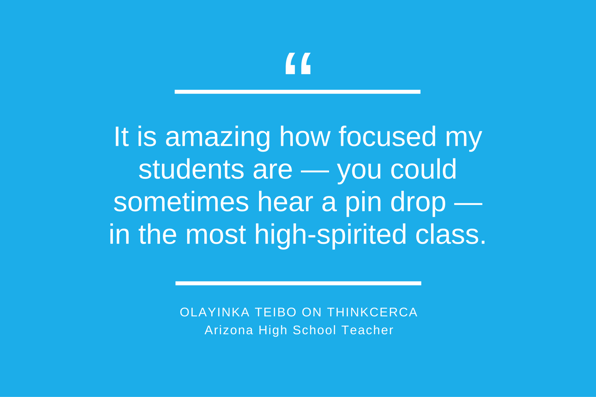
Stories from the Classroom: Yinka Teibo of West Phoenix High School
Olayinka (Yinka) Teibo teaches biology and anatomy to grades 9 through 12 in Phoenix, Arizona. A 13-year teaching veteran, she began using ThinkCERCA a year ago; all of her students have access to computer labs and Chromebooks. Yinka says she became a teacher after tutoring students and seeing the achievements the students made, despite their setbacks in life. The progress moved her and she and went into teaching full-time. Her favorite part of being a teacher is motivating her students to succeed.
We spoke with Yinka recently about her work and how she incorporates ThinkCERCA into her classroom practices. (This conversation has been lightly edited for clarity.)
How would you describe your teaching style?
My teaching style is more of a student-centered approach, and I just facilitate and assist the students in their learning “journey.” This also includes cooperative learning.
How has this style evolved over time?
I’ve tried other styles, but so far the most effective and preferable to me and the students – with the best result – is the student-centered approach. I also tweak it to fit the type of students that I have in the class, or the subject being taught. Sometimes, I do have to “lean” towards a teacher-centered approach when necessary.
How does ThinkCERCA fit with your teaching style?
For upper level—or when preparing students for upper level—inquiry, ThinkCERCA is used to enhance the learning process of the students. It made it easier for me to integrate science with reading and writing, and also work in conjunction with my language arts colleagues to get our students prepared for the new testing in Arizona (AZMerit).
How do you like to use ThinkCERCA in your classroom?
I like to have my students sit together in clusters (about 3 or 4 students) to set the stage for cooperative learning. In each cluster, I have a “team leader” and this can be rotated if necessary. Students in each cluster are at different levels of learning, including special education, ELL, and upper level. When assigning ThinkCERCA assignments, I can either have the cluster stay as they are, or move students around — with advanced students working on assignments that are at their level, and different assignments for others at their various learning stages. This has been very effective for the students and me. In some cases, an advanced level assignment is done with the mixed cluster group and they have to work as a team to come up with solutions. I sit with each team to hear what each person has to say and I’ve been amazed at the critical thinking ability of some of the students who have personal or learning challenges. I basically just tell them all that, “This is a science class, spew out what is on your mind or brain and leave me to figure it out. Albert Einstein was once like you.” It worked!
How have you integrated ThinkCERCA into your existing curriculum?
I have encouraged students to log on to the website to do assignments and also look for what may be an interesting topic or feature that they would like for us to do in class. This gives them ownership of the class. Advanced students are also given assignments that they can do at the advanced stage that they are in.
How has ThinkCERCA helped your students become stronger critical thinkers?
When an assignment is given, the article the students read (I select articles that will catch their attention) and then we discuss further on it in class. The ability of these students to think critically is amazing and I do sometimes tell them when I learned from them — when what they discussed had not crossed my mind previously.
What’s your favorite ThinkCERCA feature?
Sincerely, EVERYTHING! Actually, I like all the features. They fit easily into the length of class periods that we have.
What do your students like about it?
The fact that they can go into their own inquiry process without having to listen to the long-winded lecture of a teacher daily. Also, they make their own discoveries that they share with me or the class.
How ThinkCERCA empowered and encouraged you to become a better teacher?
ThinkCERCA has helped me to bring out the best in my students and also without the regular stress of classroom teaching. It is amazing how focused my students are — you could sometimes hear a pin drop — in the most high-spirited class. They are more engaged, and I have been able to focus more on identifying other means of getting them into deeper inquiry process.
Thank you, Olayinka, for the great insight!
